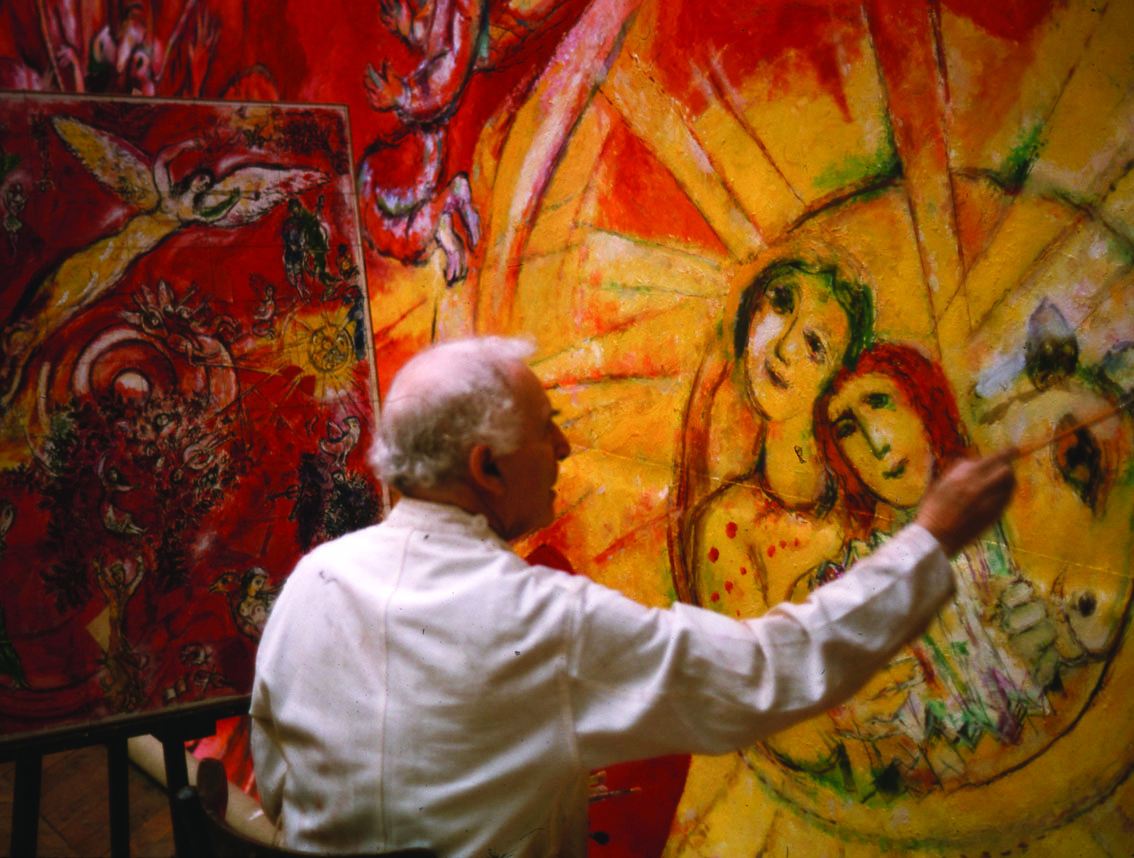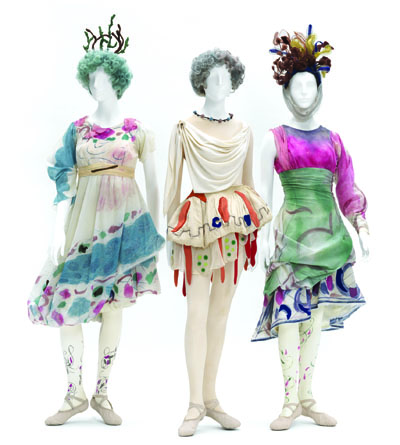 Marc Chagall working on the New York Metropolitan Opera’s “The Triumph of Music” (1966). Art © 2017 Artists Rights Society (ARS), New York/ADAGP, Paris, Photo © 2017 Isiz-Manuel Bidermanas
Marc Chagall working on the New York Metropolitan Opera’s “The Triumph of Music” (1966). Art © 2017 Artists Rights Society (ARS), New York/ADAGP, Paris, Photo © 2017 Isiz-Manuel Bidermanas Marc Chagall is best known for his fantastical paintings of folkloric shtetl scenes, circus performers, flying goats and, yes, a fiddler on a roof. His use of light and color and his romantic portrayals of Eastern European Jewish life have made him a beloved artist.
Lesser known among Chagall’s work are the richly detailed costumes and backdrops he created for ballet, theater and opera companies. Those pieces finally get their turn in the limelight in “Chagall: Fantasies for the Stage,” on view at the Los Angeles County Museum of Art (LACMA) beginning July 31.
“Our desire from the beginning was not just to do another large-scale Chagall exhibition but rather to focus on a lesser-known aspect of his production,” said Stephanie Barron, senior curator of modern art at LACMA.
“Chagall: Fantasies for the Stage” concentrates on four theatrical productions created over a quarter-century: the ballets “Aleko,” “The Firebird” and “Daphnis and Chloe,” and the opera “The Magic Flute.” All were created during and after World War II while the artist was in exile in New York.
Featured in the show are 145 objects, including 41 brightly painted costumes as well as preparatory sketches and rare 1942 film footage of the original performance of “Aleko.”
Chagall was at the forefront of artists collaborating with the ballet, theater and opera by creating fantastical and visually stunning backdrops and costumes. His work with theatrical companies and opera houses in Russia, Mexico, New York and Paris included painting sets for Sergei Diaghilev’s Ballets Russes traveling dance company as early as 1911.

© 2017 Artists Rights Society (ARS), New York/ADAGP, Paris, photo © 2017 Museum Associates/LACMA
“Chagall: Fantasies for the Stage” was organized with the help of museums in Montreal, Paris and Roubaix in northern France, and with the support of the Chagall estate.
Chagall worked in many formats, including stained glass, ceramics, book illustrations and tapestries. But one common theme was the appearance of musicians. His granddaughter Bella Meyer told the Journal that music always was an important part of her grandfather’s creative process.
“He always had records or a radio in his art studio, and very often worked while listening to music,” she said. “Most of the time, it was Mozart. And he would talk about music. He loved music.”
Meyer recalled her earliest memories of her grandfather.
“We’d go with my mother to his studio, and that’s where he would be,” she said. “After his happy and gleeful welcome, he would sit back and paint. I have many memories watching him paint.”
Barron organized the show with help from the museum’s costume and textile curators, and she leaned on their expertise to display the work.
“It’s one thing to hang a painting, put up a sculpture, do a drawing. But how you present costumes is a very complicated series of decisions that don’t happen at the last minute,” she said.
Barron previously has tapped Los Angeles luminaries like Frank Gehry and John Baldessari to install exhibitions. For this show, she turned to local opera designer Yuval Sharon and projection designer Jason H. Thompson. Sharon is the founder and artistic director of the experimental opera company The Industry and has grabbed headlines for his immersive productions staged in moving cars and at Union Station. But this was Sharon’s first time designing a museum exhibition. Barron wanted to emphasize the theatricality of Chagall’s costumes in a way that looked different than LACMA’s previous costume exhibitions, like “Reigning Men” and “Fashioning Fashion.”
“Yuval came up with this idea, which of course makes so much sense, to actually put them on stages. Normally, costumes are on platforms,” she said. “These are actually real stages with footlights and curtains and sound that comes out of the footlights and floorboards, instead of a painted deck like we usually do in museum exhibitions. So you walk in and there’s no question that you’re in a theatrical space.”
The exhibition is organized chronologically, with each of the four shows given its own area. Each section includes musical accompaniment. Also included are many of Chagall’s iconic paintings of musicians and theatrical scenes, as well as a series of video interviews featuring contemporary artists, costume designers and opera professionals.
Chagall was born in Vitebsk, Russia (present-day Belarus), in 1887. He developed an interest in theater at a young age, creating set designs for the Ballets Russes and murals and set pieces for the Moscow State Jewish Theatre.
He and his family, who were Jewish, fled Nazi-occupied France and immigrated to New York in 1941. The following year, the Ballet Theatre of New York (now American Ballet Theatre) commissioned him to design the scenery and costumes for “Aleko,” a new ballet based on Alexander Pushkin’s poem “The Gypsies” and set to Tchaikovsky’s “Trio in A Minor.”
Visitors may notice a Mexican style in the hand-painted costumes and preparatory studies. That’s because “Aleko” was supposed to debut in New York but union rules didn’t allow Chagall to paint the backdrops himself, so he and the Ballet Theatre completed work on the production in Mexico. It premiered in Mexico City, went to New York and was performed at the Hollywood Bowl in the summer of 1943.
“Aleko” led to Chagall’s second commission, in 1945, from the Ballet Theatre, of Igor Stravinsky’s iconic ballet “The Firebird,” which had premiered in Paris in 1910 at the Ballets Russes. In grief over the recent death of his beloved wife, Bella, Chagall and his daughter, Ida, threw themselves into the project, designing more than 80 costumes for “The Firebird.” The depictions of animals and monsters were beautiful and strange. It debuted at the Metropolitan Opera House in New York to great critical acclaim.
The eight costumes from “The Firebird” in the exhibition only surfaced thanks to some serious sleuthing by Barron.
In recent Chagall retrospectives, “The Firebird” was represented by only a single costume. The others could not be found. Barron and fellow LACMA curator Kay Spilker, with the help of Bella Meyer, went to the storage archives of the New York City Ballet last summer and located and negotiated the loan of “The Firebird” costumes.
“The Firebird” has stayed in the New York City Ballet’s repertoire with newer costumes. LACMA is showing the originals.
In 1956, the Ballet de l’Opéra de Paris commissioned Chagall to design new sets and costumes for Maurice Ravel’s ballet “Daphnis and Chloe.” Based on a story by a Greek poet, the blue and earthy oranges and browns of the costumes and sets were inspired by Chagall’s own visits to Greece.
Chagall’s only opera production was Mozart’s “The Magic Flute,” commissioned by the Metropolitan Opera for its inaugural season at Lincoln Center in New York in 1967. It was a complex project, with 14 sets and dozens of costumes that took him three years to make.
Chagall’s imaginative work for the stage, along with his many commissioned murals and other decorative projects, helped make him an international celebrity. But to Bella Meyer, he always was just her grandfather.
“I had no idea that he was famous. I was probably a bit naive. There could have been many hints. My mother would take us to every big opening. She would always make sure we would have a nice dress on,” Meyer said. “Everyone would call him “maître,” master. That seemed to me normal, not that it happened to any of us, but I had no understanding that he was known outside of our immediate world. I adored him as a very special, dreamlike, fantastical person. That’s how I always saw him.
“I was a teenager when it dawned on me that he might actually be famous. But he was my grandpa. He was the most humble of people.”
“Chagall: Fantasies for the Stage” will be on display from July 31 through Jan. 7 at LACMA, 5905 Wilshire Blvd., Los Angeles.






















 More news and opinions than at a Shabbat dinner, right in your inbox.
More news and opinions than at a Shabbat dinner, right in your inbox.